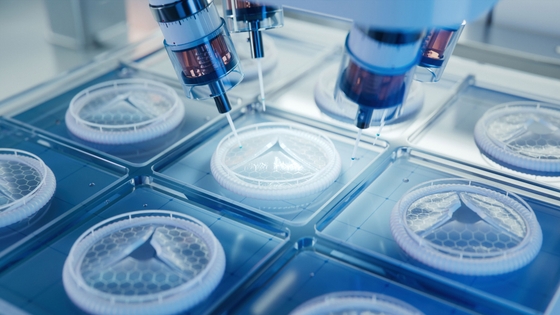
Hybrid 3D-printed imaging device for precision heart care
Transforming plaque detection with molecular insight
Precision heart care: Hybrid 3D-printed imaging device
By harnessing 3D-printing, multimodal imaging and AI, this imaging device can help spot dangerous plaques earlier and personalise treatments.
Video of blood vessel obtained by 3D printed 'camera'
See the image rendered by the hybrid 3D-printed imaging device developed by Jiawen Li and her team
Problem
Cardiology’s blind spot: current tools miss the plaques that matter most
Globally each year, millions of people with coronary artery disease suffer an acute coronary syndrome event. Most of these are caused by dangerous blockages or high-risk plaques in the coronary arteries – plaques that rupture, clot, and block blood flow. Although many plaques remain stable, others silently progress until they rupture, leading to myocardial infarction (heart attack) or sudden cardiac death. These events are often preventable – but only if we can identify and treat high-risk plaques before they become life-threatening.
Current imaging technologies lack the resolution and molecular sensitivity needed to distinguish between stable and high-risk plaques. As a result, cardiologists are often forced to make critical treatment decisions without a clear picture. This can result in overtreatment of stable lesions or missed interventions on dangerous ones, leading to recurrent heart attacks and readmission to hospitals.

Solution
A new lens on heart disease
This project has developed a next-generation intravascular imaging catheter that helps equip cardiologists to detect high-risk plaques before they rupture and cause heart attacks. The device combines two complementary, powerful imaging techniques – optical coherence tomography (OCT) which reveals plaque structure in high detail, and autofluorescence, which shows real-time molecular activity – into a single, ultra-miniaturised system.
At its core is a world-first 3D-printed micro lens-in-lens, just 0.3 mm wide – about the width of a couple of human hairs. This patented lens delivers near-cellular resolution and 12 x greater sensitivity than existing technologies.
While no current existing technology combines OCT and autofluorescence without compromising their performances, this breakthrough lens integrates both in a single device, giving a real-time view of both plaque structure and biological behaviour. This allows for earlier, more accurate diagnosis and truly personalised care.



Impact
A clearer view for better outcomes
Designed to work within existing hospital procedures, the device requires no extra training and no change in how doctors currently operate. Its ultra-miniaturised lens and catheter seeks to minimise vascular damage, while its enhanced resolution and molecular sensitivity support more confident diagnoses. By attempting to make diagnosis more accurate and personalised, this technology could help prevent heart attacks, reduce unnecessary treatments and improve patient outcomes.
Long-term, this system could also support clinical trials, to evaluate new drugs and how they may affect biological features of plaque and may be adapted for use in other high-risk clinical areas–delivering sustained impact across cardiovascular care and beyond.

What [makes] this technology so innovative is the fact that we can make this tiny 3D-printed lens that's only the size of a human hair and it can accurately detect high risk plaque that cause heart attack.
Jiawen Li
Project Lead
Wendy avoided the heart attack her brothers didn’t

After losing both her brothers to heart disease, Wendy took action. Testing revealed a 90% blockage — in time to prevent disaster.
She’s now backing a new imaging technology that could help more precisely identify high-risk plaque before they cause heart attacks.
“If my brothers had access to this kind of test, they might still be here.”
Read more about her story and how this device could mark the future of precision heart care.
Meet the team

Prof Robert Fitridge
Professor of Vascular Surgery, University of Adelaide

Dr Jessica Marathe
Interventional Cardiologist, Central Adelaide Local Health Network
Disclaimer
The information provided on this page is for general informational purposes about our Catalyst Partner’s project only - see the Disclaimer. If you have any questions or would like more information about this project or Catalyst Partnership Grants, get in touch.
You might also be interested in
.jpg?width=560&height=auto&format=pjpg&auto=webp)
What is coronary heart disease?
Coronary heart disease (CHD) or coronary artery disease occurs when a coronary artery clogs and narrows because of a buildup of plaque

Coronary artery calcium scoring
A coronary artery calcium score uses a CT scan. It measures the amount of calcified plaque (calcium) inside the walls of your heart’s arteries

Pioneering bioinspired heart valves
Next-generation 3D-printed heart valves: inspired by nature, engineered for life Tagline: Created to treat aortic stenosis and other valve conditions, this durable, low-cost heart valve uses advanced 3D printing and design inspired by the body’s natural valves to offer a safer and longer-lasting solution for patients.
.png?format=pjpg&auto=webp)











